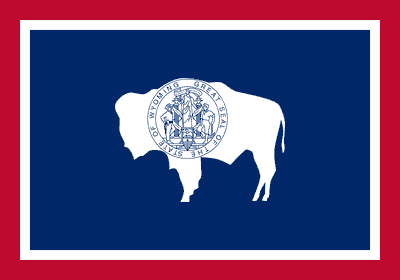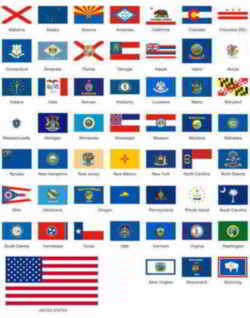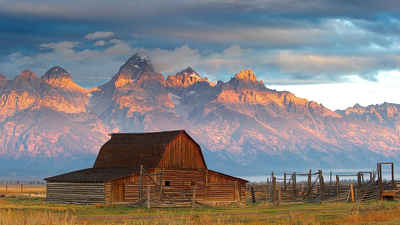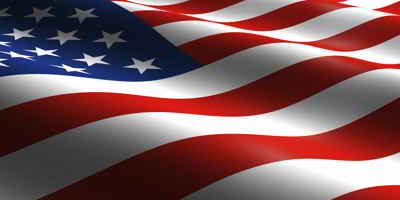Wyoming State
Flag
Adopted on January 31, 1917
The Wyoming State Flag, designed by Mrs. A. C. Keyes of Casper (formerly Miss Verna Keays of Buffalo), was adopted by the fourteenth legislature on January 31, 1917. The flag of the state of Wyoming consists of the silhouette of an American Bison. The red symbolizes the Native Americans and the blood of pioneers who gave their lives. The white is a symbol of purity and uprightness. The blue is the color of the skies and distant mountains. It is also a symbol of fidelity, justice and virility. The bison represents the local fauna while the seal on it symbolizes the custom of branding livestock
Wyoming State Flag
n 1916 the Wyoming Daughters of the American Revolution (DAR) ran a contest inviting the public to submit possible designs for a Wyoming flag. A prize of $20 was offered to the winner, and the DAR received a total of 37 entries. They chose a drawing by Verna Keays, a recent graduate of the Art Institute of Chicago. On January 31, 1917, Governor Robert D. Carey signed the state flag bill into law and the bison flag was officially adopted.
DAR regent Grace Raymond Hebard, a professor at the University of Wyoming and noted suffragist and scholar, contributed suggestions for changes after the design had been accepted. In Keays' original design, the one approved by Wyoming's legislature, the bison faces toward the fly, symbolizing its former freedom to roam the plains of Wyoming. Hebard thought that if the bison were to face toward the hoist, the design would be more balanced (animals generally face the hoist on flags, as they would the wind). In the end, all Wyoming flags from the first batch produced onward showed the bison facing the hoist, although this change was never officially adopted by the Wyoming legislature
Symbolism
A bison on a blue field bordered in white and red. The state seal branded on the bison. The woman represents the state motto "Equal Rights" and the two men represent cattle ranchers and miners. The words "Livestock", "Mines", "Grains" and "Oil" represent Wyoming's wealth. The eagle and shield show support for the United States. The dates 1869 and 1890 tell when Wyoming organized as a territory of the United States and when it became a state.
Wyoming Flag Law
Wyoming Code, Title 1, Chapter 4.
Title 8 General Provisions
Chapter 3 State Seal, Flag, Flower, Bird and Other Symbols
Section 8-3-1-2 and Section 8-3-103
§ 8-3-102. Adoption, use and specifications of state flag; penalty for misuse.
a) A state flag is adopted to be used on all occasions when the state is officially and publicly
represented. All citizens have the privilege of use of the flag upon any occasion they deem
appropriate. The width of the flag shall be seven-tenths (7/10) of its length; the outside
border shall be in red, the width of which shall be one-twentieth (1/20) of the length of the
flag; next to the border shall be a stripe of white on the four (4) sides of the field, which
shall be in width one-fortieth (1/40) of the length of the flag. The remainder of the flag
shall be a blue field, in the center of which shall be a white silhouetted buffalo, the length
of which shall be one-half (1/2) of the length of the blue field; the other measurements of
the buffalo shall be in proportion to its length. On the ribs of the buffalo shall be the great
seal of the state of Wyoming in blue. The seal shall be in diameter one-fifth (1/5) the length
of the flag. Attached to the flag shall be a cord of gold with gold tassels. The same colors
shall be used in the flag, red, white and blue, as are used in the flag of the United States
of America.
(b) All penalties provided by the laws of this state for the misuse of the national flag are
applicable to the state flag.
(Laws 1917, ch. 8, § 1, 2; C.S. 1920, § 4525; Laws 1927, ch. 20, § 1; R.S. 1931, § 106-101;
C.S. 1945, § 18-2202; W.S. 1957, § 8-44; W.S. 1977, § 8-5-102; Laws 1978, ch. 37, § 1.)
§ 8-3-103. State historian to purchase state flags; use.
It is the duty of the state historian to purchase not less than six (6) state flags. The flags
shall be kept at the office of the state historian to be loaned under rules and regulations
he prescribes to any citizen, or group of citizens, of the state for use on such occasions
when the state is officially and publicly represented, or when public assemblies or gatherings
are held. If any flag is borrowed from the office of the state historian, the citizen, or group
of citizens, borrowing the flag shall deposit with the state historian a certified check in
an amount sufficient to repair or replace the flag, if damaged or lost. No deposit is required
of any officer of the state government who may be called upon to represent the state at any
official function.
(Laws 1917, ch. 8, § 1, 2; C.S. 1920, § 4525; Laws 1927, ch. 20, § 1; R.S. 1931, § 106-101;
C.S. 1945, § 18-2202; W.S. 1957, § 8-44; W.S. 1977, § 8-5-102; Laws 1978, ch. 37, § 1.)

The Flags of the US.







